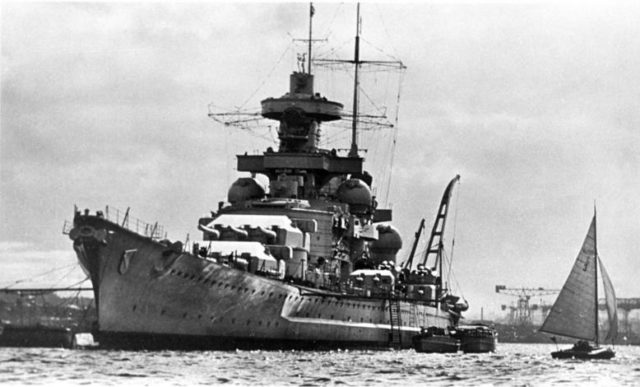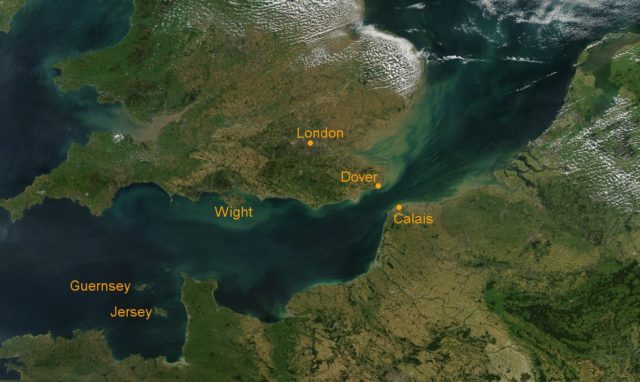Most of the naval action of WWII took place in the vast spaces of the Atlantic and Pacific Oceans, but there were also confrontations in smaller seas. One such encounter took place in February 1942 in the English Channel.
Shelter in Brest
In early 1941, the German battlecruisers Scharnhorst and Gneisenau were active in the Atlantic. There they attacked the convoys that were so vital to keeping Britain supplied during the war. The German’s activities were cut short when their supply ships were hit by Swordfish torpedo bombers flying from the British aircraft carrier Ark Royal.
In April, the two German vessels took shelter in the occupied French port of Brest. The following month, the German heavy cruiser Prince Eugen also took refuge there when it became separated from the Bismarck.
In the following months, there were repeated attacks by Allied bombers against the ships. Sitting in a port with access to the Atlantic, they were too much of a threat to convoys to be left alone. Despite determined efforts, they remained afloat.

A Dash Toward Safety
The three ships were effectively under siege which rendered them next to useless. It was a situation the Germans were about to remedy.
One of the reasons for moving the ships from Brest was the desire to free them from the unrelenting bombardment. They had undergone repairs and were ready for action which was undoubtedly a factor. So too was Hitler’s perception of the war. He suspected the Allies were about to invade Norway, to reverse their defeat there earlier in the war. He wanted his battlecruisers on hand to stop that invasion.
By the beginning of February 1942, the ships were ready to leave. Thirteen motor torpedo boats and five destroyers were assembled to accompany them. Air cover was arranged to fend off Allied bombers during the journey.
They were about to make a dash for Kiel in Germany further north; up the English Channel.
Intelligence Behind the Scenes
Meanwhile, in Britain, evidence was piling up of the Germans’ plans.
From the start of the war, the Royal Navy had had the most effective intelligence gathering and analysis of any British forces, perhaps of any nation in the war. This apparatus collated a range of information on the ships at Brest. Intercepted signals, photo reconnaissance, and information from agents in occupied Europe all pointed to the fact that the ships were ready to leave. Bombing raids had failed to put them permanently out of action.
On February 3, more details were obtained from Britain’s highest level source, Ultra. The interception and decryption of Germany’s top-level Enigma code informed the Admiralty about the boats being assembled as an escort.
By February 8, Coastal Command predicted the ships might leave anytime after the 10th, but they could not be more specific.
Despite the intelligence gathered, the British were convinced the ships would set sail during the day, to reach the narrows of the Channel under cover of night. Therefore, when the German flotilla set out under cover of darkness on February 11, the British were caught unprepared. By the time they realized what was happening, it was 1 am on February 12, and the ships were about to pass Boulogne.
Fighting in the Air
The British scrambled Swordfish biplanes to attack the German ships. They had scored successes during the hunt for the Bismarck and in attacks on supply ships. They were outdated aircraft, and their fighter escort arrived too late. No match for the German Messerschmitts, they still courageously pushed their attack to the end. None of their torpedoes hit.
Another wave of bombers was launched, complete with fighter cover. 242 bombers set out to attack the flotilla, but due to bad weather, not all of them found their targets. Those that did once again faced the Messerschmitts as well as anti-aircraft fire. As at Brest, they were unable to do serious damage to the battlecruisers.
One RAF pilot, a French exile, and former sailor escaped death by pure luck when he joined a German formation in the confusion above the Channel.

Missing at Sea
The fighting at sea went no better for the British. They did not have in the region a fleet capable of engaging with the Germans. Motor torpedo boats were held off by German escorts, and bad weather kept the Dover shore batteries from hitting their targets.
A group of WWI era destroyers, usually used as escort vessels, rushed to intercept. However, they arrived too late to engage with the Germans effectively or to block their path.
Mines
Having worked out the German’s route, British naval intelligence directed Bomber Command to lay mines ahead of the German vessels. The bombers crossed the area laying mines only hours before the German ships arrived.
As they steamed along the coast toward safety, both the Scharnhorst and the Gneisenau hit some of the mines, but they caused minor damage. The battlecruisers limped home with the rest of their squadron, arriving at Kiel on February 13.
Despite the intelligence they had gathered, the British had missed an opportunity. Still, the damage done by the mines meant the ships were in dry dock once more. There, on February 26, Allied bombers finally destroyed the Gneisenau and put the Scharnhorst out of action for a year.
Sources:
Ralph Bennett (1999), Behind the Battle: Intelligence in the War with Germany 1939-1945.
Richard Russell Lawrence, ed. (2003), The Mammoth Book of How It Happened: Naval Battles.
